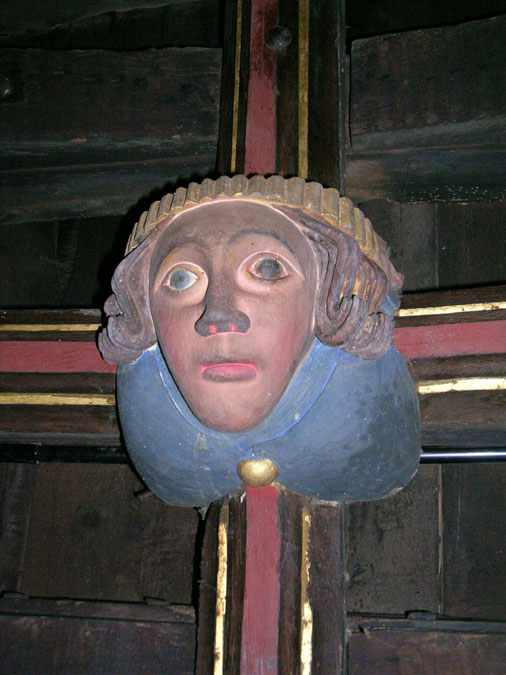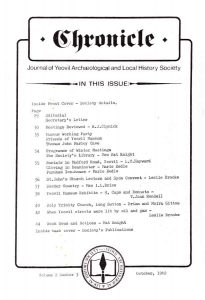This article came from Chronicle published October 1982. Pages 40-42
Holy Trinity Church, Long Sutton
Authors: Brian and Moira Gittos
On 14 May, members of the Society visited Long Sutton, meeting at Holy Trinity Church. The following notes were compiled in preparation for the tour of the church.
Little is known about the early history of Long Sutton church. Collinson states that in 852 King Alfred gave the manor to the Church of Athelney, but there is no mention of the church until c1198 when Collinson claims that Bishop Savoricus, Abbot of Athelney, ‘erected the Church of Long Sutton into a Prebend of Wells Cathedral’. The remaining evidence for this 12c church is slight. There are four stones with romanesque architectural carving, including a voussoir with bold chevron marking preserved with other items under the pulpit. Nearby, a Norman piscina (in its original position?) is built into the pillar at the east end of the north nave aisle and part, of an early colonnette is built into the interior wall near the south door. Evidence for the building which succeeded the Norman church is equally tenuous, but two blocked squints probably date from the post-Norman period and the plain jambs of a south aisle window are probably associated with an earlier window. The scant remains of the early church can be explained by the thorough rebuilding in the Perpendicular style at the end of the 15c.
The present church is important because (excepting some minor additions) it was remodelled, as a coherent design, in a short period in the early 1490s, just as Yeovil St John’s exhibits an unaltered scheme from the previous century. The rebuilding at Long Sutton is corroborated by documentary evidence. A licence was granted in 1493 by Bishop Fox to Thomas Cornish, Bishop of Tenos (sic) to ‘dedicate, consecrate, and bless, the church of Long Sutton with its cemetery lately rebuilt’. A Thomas Cornysh was warden of the College of Ottery St Mary from 1489-1511 and he is mentioned by the 15c traveller William of Worcester. Most of the church now dates from the 1490 rebuilding. The south porch is the most evident addition, together with the north chapel (perhaps?). However, in both cases the alteration was made soon after the rebuilding, probably early in the 16c. Mr Poyntz-Wright claims that the tower was built in 1462, but his evidence is far from conclusive and it is more likely to be contemporary. with the rest of the building. The tower should be compared with Langport, Muchelney, and Weston Zoyland. The nave arcades are in the plain Perpenstyle and the tower arch and the arches to the chapels show typical panelling. The tower has a dramatic lierne star vault. Throughout the church, the window patterns form a logical sequence of Perpendicular tracery, exemplifying the coherence of the overall design.
The church is rich in 15c woodwork, the impressive north and south doors on original hinges are noteworthy, as is the Somerset-style roof with king-posts, carved tie-beams and supporting angels. It is similar to High Ham, Somerton, and Martock, but less elaborate. The contemporary rood screen is of the Devon type and has been restored. This is also unfortunately true of the pulpit which has been dated to the late 1450s from initials incorporated into the design. It suffered a drastic ‘restoration’ in 1868, and the carved figures were added in 1910. It is,perhaps, strange that the pulpit should have survived the rebuilding, and further doubt is cast by the fact that the initials J.P. carved on a panel could apply to John Pym, vicar at the time of the rebuilding. J.P. is suggested in the VCH to represent John Petherton, Abbot of Athelney 1425-58.
The 15c octagonal font has a Jacobean cover, and the chancel’s wagon roof was restored in 1962 with a grant from the Historic Churches Preservation Trust. In the north chapel there are some medieval encaustic tiles. Long Sutton has six bells. The oldest, from an Exeter foundry, dates fron the 15c. It is interesting to note that the builders of Long Sutton seem more influenced by Devon craftsmen than by North Somerset and Bristol, with a Devon screen and an Exeter bell.
The church is built of local liar block with Hamstone dressings, and a perambulation of the exterior reveals several interesting features. On the parapet above the north porch sits a shapeless lump of masonry, claimed by Mr Buckle to represent the headless figure of a mason, which he likened to a mason portrayed on the Groge Inn at Glastonbury. This fanciful suggestion could be tested by closer inspection. On the gable at the east end of the nave is a more recongisable carved fifure said to represent an Abbot of Athelney. The addition of the south porch is more readily appreciated from without, the buttresses having been cut away to accept it. Some time in the last century, this porch was converted to use as a vestry by blocking the outer doorway and adding a small window. The stoup on the west face of the tower is an unusual feature and also surprising is the date of 1622 which appears on the west face belfry tracery. This could relate to a repair of that part of the tower or, as suggested in the VCH, indicate that the tower was not completed until 1622. The former is more likely.
In the churchyard there is the base of a 15c cross carved with figures on four sides and near the gate’are tomb panels bearing quatrefoils and some window tracery.
On first inspection, Long Sutton appears to be devoid of medieval monuments, but detailed examinations of two loose carved heads and several fragments beneath the pulpit, tell a different story. The head on a bracket in the north chapel shows a male figure with curling hair, his slightly inclined head resting on a cushion. On a south aisle window sill is the matching head of a lady, and the other fragments are of drapery and limbs, including a foot, all of which probably belonged to one monument. When complete it would have comprised the recumbent effigies of a civilian and wife carved on one Hamstone slab and richly decorated (traces of colour remain). The date of the monument would be early in the 14c and it closely resembles the double slab preserved in Limington church and the two weathered figures to be seen beside the Petherton Bridge on the A303. This unrecorded pair of medieval effigies has escaped the notice of A.C.Fryer, who wrote a full account of medieval effigies in Somerset, and as such deserves special consideration. It is intended to submit a detailed account of the monument for publication in the Proceedings of the Somerset Archaeological and Natural History Society.
In conclusion, Long Sutton is an interesting example of a late 15c church in terms of the coherency of its architecture and fine fittings. However, sufficent evidence remains to indicate at least two earlier periods of building, including a late Norman church with a well-carved. portal.
References consulted:
Victoria County History of Somerset vol-3,pp.154-155
Fryer,A.C., Monumental Effigies of Somerset (Proc.S.A.S. LXI-LKXVI)
Buckle, Visit to Long Sutton Church, Proc.,’S.A.S 40,p.37.
Collinson,J., History of Somerset, 1791.
Church Guide to Holy Trinity, Long Sutton.
Pevsner,N., The buidings of England – South and West Somerset.
Poyntz Wright,P., The Parish Church Towers of Somerset, 1981.

